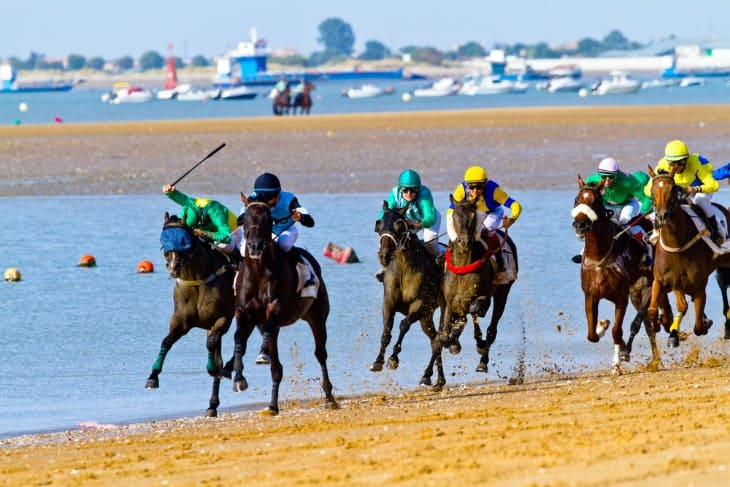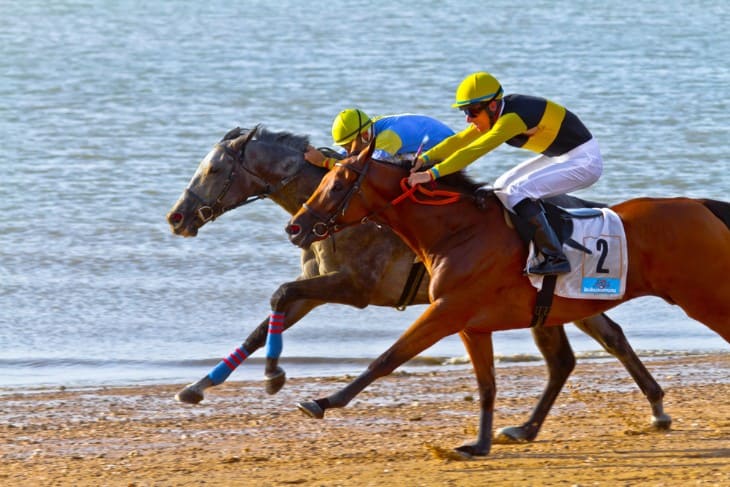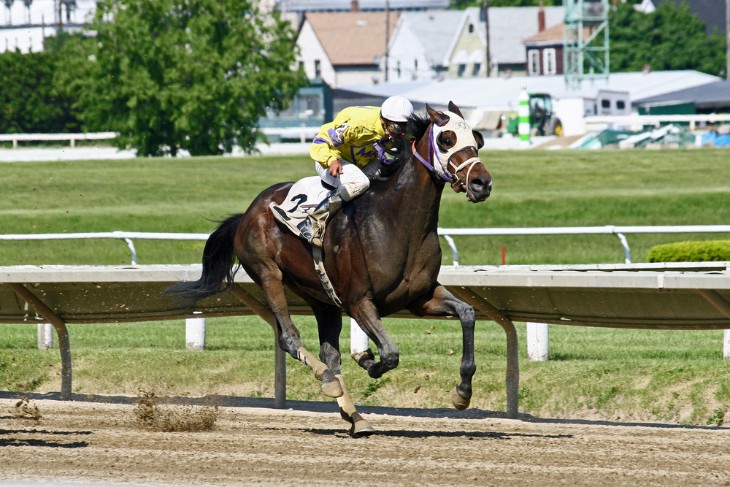- What Does "Off the Bridle" Mean?
- Signs That a Horse Is "Off the Bridle"
- Factors That Cause a Horse to Go "Off the Bridle"
- The Part of the Jockey When a Horse Is "Off the Bridle"
- Impact on the Race Outcome
- Methods for Keeping a Horse 'On The Bridle'
- Noting when horses go "Off The Bridle" in major races
- Bottom Line
Horse racing, commonly referred to as the "Sport of Kings " , boasts a rich heritage and a unique lexicon. Terms like "off the bridle" play a role in grasping the nuances of this pastime. These expressions depict the behaviour of a horse, actions taken by a jockey and various aspects of racing. Whether you're a bettor or simply an occasional enthusiast, having this knowledge can enhance your appreciation for the sport.
What Does "Off the Bridle" Mean?
In horse racing, being "off the bridle" means that a horse is struggling to keep up with its pace. When horses are "off their bridles", jockeys no longer hold reins tightly; instead, they encourage them to run faster by using whips or pushing them harder.
A horse that is off its bridle has lost its smooth stride; it no longer runs easily but needs extra motivation. This is in contrast to being 'on the bit' or 'on the bridle', where everything appears smooth and effortless from a spectator's point of view. When horses run on their bits, they look comfortable and controlled.
Going 'off the bridle' shows tiredness during races – now riders have to be more aggressive (using whips) while driving horses forward. In such cases, animals might throw their heads higher than they usually do, breathe more heavily or take shorter breaths between strides, make slower strides, etcetera – all these signs indicate that it is already working hard and not running easily anymore.
This term matters because it tells us about one stage in which any given racehorse may find itself at some point within a particular contest on any given day. By doing so, punters can know which mounts were still strong enough to keep going when others were conspicuously failing before their eyes, thus enabling them to predict outcomes better.
Knowing what it means when we say something is 'off its bridle' also enables us to appreciate both horse and rider more. It underscores the challenges encountered during races and the sacrifices made before performing well. Therefore, watch out for these signs next time you are at the tracks.
Signs That a Horse Is "Off the Bridle"
Below are some of the most common indicators that a particular horse is off its bridle:
- Jockey's Actions: When horses are off their bridles, riders change their tactics too; they release reins and push mounts harder than ever. To achieve this objective, jockeys may use whips frequently to make them go faster. What's more? You will see hands moving up and down and bodies swinging from side to side when urging them forward vigorously.
- Horse's Behaviour: Behaviour changes occur once an animal goes 'off its bridle'. For example, it tends to raise its head higher than usual, which shows discomfort while running. Heavy breathing could also be noticed, coupled with shorter strides. Hence, it becomes evident that this particular horse has become tired, probably because it cannot keep up with others anymore due to fatigue brought by the fast pace set by leaders.
- Rhythm Change: One thing that can never go unnoticed is when the rhythm changes abruptly because then one knows without a doubt what has happened. A particular contestant might have gone off their bridle! So look out for those moments when everything starts happening differently from what was expected or anticipated because such moments mark turning points in races.
- Laboured Breathing: When a horse is "off the bridle," breathing becomes more complex and intense. Essentially, the animal takes in heavier breaths, showing it's working harder than usual. This means that the horse is overexerting itself to stay in the race.
These signs help fans and bettors understand the horse's condition during the race. By spotting these changes, you can tell which horses are struggling and which are still running strong. This knowledge can help predict the race outcome and add to your enjoyment of the sport.

Factors That Cause a Horse to Go "Off the Bridle"
There are many reasons why a horse may go "off the bridle" while racing. Here are some common ones:
- Pace of the Race: If a horse is going slower than its normal pace because of another racer or Jockey urging it on too quickly so they don't fall behind – that could also cause it to become off-balance
- Fitness Level: A lack of fitness will cause any living creature to tire rapidly; therefore, if an equine does not have adequate physical activity before races, then it will peter out faster, all other things being equal, such as weight carried, etcetera, needed for peak performance at those distances.
- Race Distance: Longer races require more stamina. Suppose the distance is beyond what a particular runner can handle comfortably. In that case, this might create problems later when they get tired towards endpoints after starting strong, only to begin fading away and eventually becoming wholly depleted altogether.
- Track Conditions: Soft or heavy ground makes it harder for horses to maintain their pace. Muddy or uneven tracks increase the effort needed to run. So if a horse finds itself running on such tracks, it will use up more energy, which may force them into going off the bridle earlier than anticipated by their trainers because they are already tired from excessive exertion caused by unfavourable terrain features encountered during races.
- Competition Level: The level of competition also affects a horse's performance. A horse may need to push harder in a race with stronger competitors to keep up. This added pressure can cause the horse to go "off the bridle" if it cannot match the speed of the other horses.
Understanding these factors helps trainers and jockeys prepare better for races. It also gives fans insight into why a horse might struggle during a race. By considering these elements, you can better predict race outcomes and appreciate horses' challenges.
The Part of the Jockey When a Horse Is "Off the Bridle"
A jockey's role becomes important when a horse is said to have gone "off the bridle". The Jockey needs to react fast and efficiently in order to keep the horse running. What they do can make or break the performance of that particular horse as well as affect the outcome of the race.
In the first place, the rider loosens his grip on the reins by no longer holding them tightly; instead, he starts driving forward. This may mean using the whip more often than before; it helps motivate the animal to put extra effort into its movement. What matters most here is timing and skillfulness—how best should one use the whip so that it receives maximum cooperation from such an animal?
The other thing he does is change his body position, dropping his body downwards towards the neck region of this beast so as to minimise air resistance that could have been encountered while sitting upright, thereby making it move faster with less struggle. Additionally, some parts of his body move up and down rhythmically, which signals the horse pushing harder.
Another tool riders use is voice encouragement. They shout or talk into the ears of their animals, which sometimes makes them run faster. Horses respond well when spoken to by people they are familiar with, thus giving them more energy than ever.
When a horse goes "off the bridle," maintaining a steady rhythm becomes very important, too. The Jockey must try as much as possible to not only guide the horse but also ensure that it keeps up since any good rider knows how far to push without overworking.
It requires experience coupled with expertise in handling such situations. For instance, veteran riders understand what amount horses can afford to give out and how to achieve this effectively, enabling them to always achieve optimal results. They also know when to push hard and relax a little bit, depending on prevailing conditions at any given moment during the race.
Jockeys play significant roles in races whenever horses go off bridles. Their actions and decisions can either positively or negatively impact the overall outcome of the race. By using a whip, adjusting body position and giving vocal encouragement, riders make their horses perform to the best of their abilities.
Impact on the Race Outcome
When a horse goes "off the bridle," it has significant implications for how that particular race will end. The term means that the animal is struggling and requires additional motivation from its rider; hence, it may need to finish more strongly than others. Being aware of this fact helps fans and betters predict which horses are likely winners or placers.
If one observes keenly, one will see that any horse that goes off the bridle early usually drops behind the leading pack since it uses up too much energy within a short period, thus becoming tired before reaching the finishing line, reducing the chances of coming among the top finishers. This is what punters look out for when making adjustments to their predictions so far concerning such events.
Those trainers who handle such animals understand them better than anyone else because they deal with them daily during training sessions, thus enabling owners to come up with appropriate plans based on these signs exhibited by each horse while participating in different races. Such preparations may include more conditioning exercises or even changing race strategies if needed; otherwise, things will work out differently. It would therefore be important for people involved in this sport not to overlook anything whenever necessary, hence improving overall performance levels even further
Knowing when a horse is "off the bridle" makes watching a race more interesting for the audience. It shows how much effort and ability it takes to ride horses in races, and being able to tell this helps people understand what the animals and their riders are up against during races.
If a horse goes "off the bridle," it can completely change how the race will play out. This affects how well the horse performs and who wins overall. Fans or betters who can spot these things clearly know what might happen next and why.

Methods for Keeping a Horse 'On The Bridle'
To ensure that the horse performs at its peak, keeping it 'on the bridle' throughout the race is essential. Below are strategies that can be employed:
- Pacing of the Horse: Correct pacing saves the horse's energy. The trainers and jockeys ensure the horse is strong enough to prevent early tiredness and keep it in action longer. A constant pace is maintained, and the animal is less likely to go off during the early stages.
- Training Programme: The training program design should enhance horses' endurance and fitness levels. Regular exercises, along with conditioning them, prepare these animals for racing requirements. In this case, they can remain in top condition for extended periods while being ridden or raced. Training also involves trial runs, which simulate actual races, thus building confidence in runners.
- Right Nutrition: The physical needs of horses are supported by feeding them well-balanced diets. Optimum performance is achieved by providing enough energy-giving foods with all the necessary nutrients required by such animals at any given time. Feeding different types of food mixes ensures that they have enough strength and stamina so as not to fall easily during intense activities like racing games or competitions, among others, based upon individual nutritional requirements, taking into consideration scheduled races coupled with training intensity levels, among other factors.
- Tactical Rides Taking: During a race, riders save their mounts' power using tactics. They do not squeeze out everything from their rides too soon but instead guide them carefully until when it will matter most – towards the home stretch or last part where the finish line awaits ahead, marking the endpoint for each heat; therefore this approach helps maintain steady rhythm keeping every runner within reach throughout most of any given event thereby enabling achievement desired outcome ultimately leading success staying "on top" always.
- Monitoring Weather Track Conditions: Trainers must be well informed about the state of tracks during training sessions. This knowledge guides them when selecting which type of horse suits what kind of race event, considering whether soft, heavy, or firm track conditions prevail at that particular moment. By making necessary adjustments accordingly, trainers can ensure better performance levels, helping animals run more effectively while still being ridden on top form for more extended periods before tiring out completely.
These are just some methods used to keep a horse 'on the bridle' throughout its races; they conserve energy and ensure optimal performance. Trainers and jockeys who use these techniques will increase their chances of finishing strongly with every horse ridden under their care.
Noting when horses go "Off The Bridle" in major races
Watching significant horse racing events provides excitement and insights, especially if one understands terms such as 'off the bridle'. This observation can easily be made in major races like the Grand National or the Cheltenham Festival, and then we can see how it affects each race's outcome.
When it goes off during such essential competitions where lots are staked, what jockeys do next becomes vital because you may notice them pushing harder themselves, starting to hit frequently while moving hands and bodies more vigorously than before, which shows a struggle to keep up with those animals involved.
During these high-stakes horse tournaments, every single competitor pushes themselves beyond limits – no matter whether they participate individually together with others representing different countries around the world; thus, making comparisons between tiredness and remaining energy levels among various participants quite interesting thing observe also helps predict possible results finish line based on when exactly specific riders start looking tired due physical exertion put forth progressively throughout entire length racecourse over time as whole duration event itself unfolds step by step until reaching climax or culmination point any given contest irrespective nature sport discipline involved there.
Track conditions also greatly affect the outcome of major contests, especially softer ground types that tend to cause some runners to go "Off The Bridle" more quickly than expected. The manner in which various entrants handle such situations can give one an idea about their strengths and weaknesses. Therefore, those able to stay longer on challenging tracks usually have better conditioning and are more skilled than others.
Jockeys in major races have a lot of experience. Their ability to handle a horse when it goes "off the bridle" is fantastic. You can learn much about horse racing by studying what they do.
Adding on the knowledge of what being "off the bridle" means will take your race-watching to high levels. This shines a light on both horses' and jockeys' problems, making you love the game more. These indications will help you enjoy the sport better as a fan, a punter or even someone new who wants to know how to predict race outcomes while watching.
Bottom Line
Knowing what "off the bridle" means in horse racing gives you an understanding of how this sport works. It shows some of the difficulties that horses go through during races and why jockeys are essential in maintaining performance levels. Fans and bettors can make wiser predictions if they recognize signs or factors associated with this condition.
Also, it helps them appreciate skills used in controlling racehorses because there is always one behind every good run or lousy run storyline that people need to talk about more often than not, especially if such a person has been involved either directly or indirectly with horses for some time now; therefore it does not matter whether one is new or old follower of horse racing but these things are still essential components which make up part of our thrilling experience whenever we look forward towards participating actively within equestrian events industry again.
For more information:








